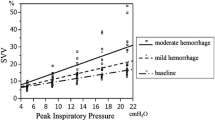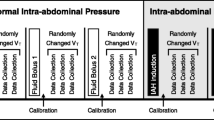Abstract
Both tidal volume and effective blood volume may affect the variation in the arterial pressure waveform during mechanical ventilation. The systolic pressure variation (SPV), which is the difference between the maximal and minimal systolic pressure values following one positive pressure breath was analyzed in 10 anesthetized and ventilated dogs, during ventilation with tidal volumes of 15 and 25 ml/kg. The dogs were studied during normovolemia, hypovolemia (after bleeding of 30% of estimated blood volume) and hypervolemia (after retransfusion of shed blood with additional 50 ml/kg of plasma expander). The SPV reflected hemodynamic changes and was maximal during hypovolemia and minimal during hypervolemia. Unlike all other hemodynamic parameters it was also affected by the tidal volume and significantly increased at higher tidal volumes during each volume state. We conclude that the SPV and its components are useful parameters in evaluating the intravascular volume state. They also reflect the magnitude of the tidal volume employed.
Similar content being viewed by others
References
Cournand A, Motley HL, Werko L, Richards DW (1948) Physiological studies of the effect of intermittent positive pressure breathing on cardiac output in man. Am J Physiol 152:162–173
Morgan BC, Crawford EW, Guntheroth WG (1969) The hemodynamic effects of changes in blood volume during intermittent positive-pressure ventilation. Anesthesiology 30:297–305
Grace MP, Greenfarm DM (1982) Cardiac performance in response to PEEP in patients with cardiac dysfunction. Crit Care Med 10:358–360
Jardin F, Farcot JC, Gueret P (1983) Cyclic changes in arterial pulse during respiratory support. Circulation 68:266–274
Robotham JL (1981) Cardiovascular disturbances in chronic respiratory insufficiency. Am J Cardiol 47:941–949
Perel A, Pizov R, Cotev S (1987) The systolic blood pressure variation is a sensitive indicator of hypovolemia in ventilated dogs subjected to graded hemorrhage. Anesthesiology 67:498–502
Pizov R, Ya'ari Y, Perel A (1988) The systolic pressure variation is greater during hemorrhage than during sodium nitroprusside-induced hypotension in ventilated dogs. Anesth Analg 67:170–174
Bennet FM, Tenney SM (1982) Comparative mechanics of mammalian respiratory system. Respir Physiol 49:131–140
Nunn JF (1969) Applied respiratory physiology with special reference to anesthesia. Butterworths, London, pp 55–67
Coyle JF, Teplick RS, Long MC et al (1983) Respiratory variations in systemic arterial pressure as an indicator of volume status (Abstract). Anesthesiology 59:A53
Perel A, Pizov R, Ya'ari Y, Segal E, Cotev S (1988) The arterial pressure waveform during acute ventricular failure (Abstract). 9th World Congress of Anesthesiology, May 22–28, Washington, DC
Jansen RCJ, Schreuder JJ, Bogaard JM (1981) Thermodilution technique for measurement of cardiac output during artificial ventilation. J Appl Physiol 51:584–590
Author information
Authors and Affiliations
Additional information
Supported by the Ministry of Industry — Hadassah Foundation for Applied Research, and partly by the MJF foundation
Rights and permissions
About this article
Cite this article
Szold, A., Pizov, R., Segal, E. et al. The effect of tidal volume and intravascular volume state on systolic pressure variation in ventilated dogs. Intensive Care Med 15, 368–371 (1989). https://doi.org/10.1007/BF00261495
Received:
Accepted:
Issue Date:
DOI: https://doi.org/10.1007/BF00261495




